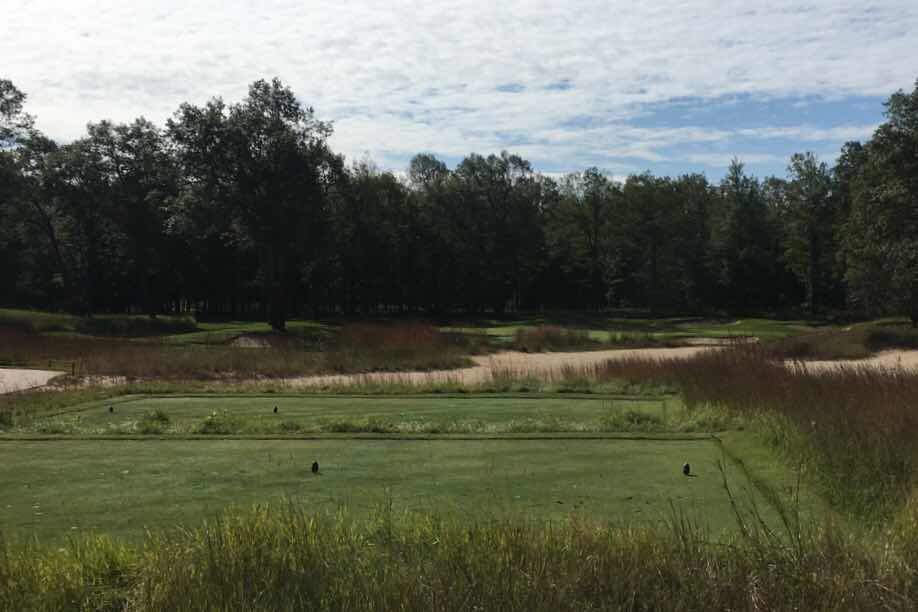
#21 Top 100 Public (Golf Magazine)
#28 Top 100 Public (Golf Digest)
#72 Top 100 Courses USA (Golf Magazine)
#99 Top 100 Courses USA (Golf Digest)
Forest Dunes is three hours north of Detroit within the Huron Manistee National Forest. It is well off the beaten path, but it’s immaculate conditioning and secluded location make for an incredible day of golf.

(Standing on the first tee, the player inhales all the qualities that makes Forest Dunes a top 25 in country course.)
Tom Weiskopf designed Forest Dunes in 2002, and it is regarded as one of his best. He took advantage of a terrific piece of property by routing the course through a pine forest, grasslands, and dunescape. Each hole is separate from the other, offering only a glimpse here and there of another hole.

(The green of the par five fifth has several good pin locations. This is the view from the left. Note the raised rear and slight depression on the right. Birdie is a well earned score.)
Weiskopf ‘s design philosophy is much different than Ohio State alum Jack Nicklaus. His courses are playable and the shot values are not over the top. Forest Dunes emphasizes this trait. It’s a collection of solid hole after solid hole. They dogleg left, they dogleg right, some long, some short, some medium, but the routing always changes the challenge from the previous hole.

(The eighth doglegs right around the bunker in the foreground. Longer hitters can try to carry it while the conservative play is laying back. The green is pressed into the water with short left being safe. The gorgeous clubhouse comes into view for the first time, framing an already beautiful setting.)
Forest Dunes benefits from having a great set of greens. They have one or two significant features in them, and this allows for some great pin placements. It also allows the golfer to plan his attack from the tee, knowing that such and such pin needs to be approached from this angle. For the better player, such a design is pure bliss. And might I add that these putting surfaces roll fast and true. They might be some of the best greens you’ll ever putt on.

(The par three eleventh is over sand and natural areas to a green bisected by a roll in the middle...

...it’s imperative to be on the correct half of the green otherwise it’s a tough two putt for par. The holes on this side of the property feel like being in the Sandhills of NC.)

(The twelfth doglegs left to a green protected by water and sand. One observation is the lack of a “wow” hole, but never is there a awkward or lackadaisical one. Each hole requires a strong tee shot and well struck iron. I’d say it’s a pure golf with no fluff.)
Setting is something that often gets overlooked when discussing courses. When a property has several different environs, it’s always intriguing to me to see how the architect winds the holes in and out of each, and blends it into a strong cohesive routing. Forest Dunes does that effortlessly, and much praise has to be given to Weiskopf.

(The fourteenth is the longest par four on the course. The approach is to a wide but shallow bi level green with the lower section being on the left by the water. Note the pin is left of the center front bunker. Every shot hit to this area, whether it’s the approach, a chip, or a putt, is very difficult.)

(If you’re of the opinion that a par three near the end of the round should be a stout one shotter, then sixteen will resonate with you. It plays well over 200 yards, and is an intimidating view with sand and vegetation staring you in the face. Weiskopf left plenty of fairway short to bounce the ball onto the green. A par is good work.)
No Weiskopf course would be complete without a drivable par four, and Forest Dunes seventeenth is one of the best.

Standing on the tee, a sliver of fairway is seen with sand hugging both sides. The widest part is the fifty yards short of the green, which encourages the player to pull out the driver.

A conservative tee shot leaves a straightforward pitch, but being too far right can make the angle awkward.

This view shows just how much sand protects the line of charm to the green. Taking on the challenge can lead to eagle, but a miscue can lead to disaster.

(Eighteen stays in the sand dunes and plays straightaway with water left on this reachable par five. The gorgeous clubhouse comes back into view and all the ingredients are present for a fantastic finish.)
Forest Dunes finds itself in some elite company. Golf Digest ranked The Loop, Tom Doak’s reversible golf course, as two separate courses which now gives them three courses ranked in the top 50 in USA. Obviously The Loop has been getting a lot of recognition with its revolutionary design, but as Golf Channel’s Matt Ginella stated, it’s only possible because Forest Dunes is such a great course that Lew Thompson could afford to take the risk. That’s a pretty big statement when you think about it. I concur. I give Forest Dunes an 8 (excellent)(worth spending a weekend to play).

(Forest Dunes has a 19th hole to settle any bets that didn’t get resolved on eighteen. It’s a short par three with a bunker in the middle of the green. Yes it’s in the middle of the green!)
The Loop review:
Forest Dunes is only five hours from Cleveland. It compares favorably to Sand Valley in Wisconsin and Streamsong in Florida, and at a better price point too. It’s a great guy trip! I highly recommend it!!
